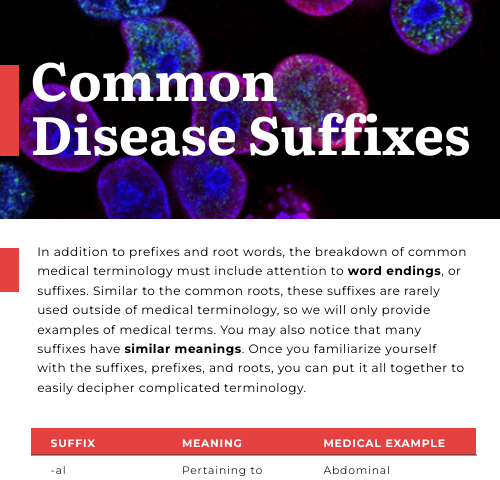
Common Disease Suffixes
As Certified Nursing Assistants (CNAs), it’s crucial to have a basic understanding of medical terminology. This understanding allows for effective communication with the rest of the healthcare team and enables CNAs to provide quality care to their patients. A fundamental aspect of medical terminology is recognizing disease suffixes. These are ending parts of words that often indicate the type, symptoms, or location of a disease. This blog post will discuss some of the most common disease suffixes that CNAs are likely to encounter in their practice.
What is a Suffix?
Let’s start by first defining what a suffix is. In language, a suffix is a letter, syllable, or group of syllables added at the end of a word or word root to change its meaning, give it grammatical function, or form a new word altogether. Suffixes are one of the three primary types of affixes—the other two being prefixes, which are added at the beginning of a word, and infixes, which are inserted into a word.
When it comes to medical terminology, suffixes play a crucial role. They can indicate a procedure, a condition, a disease, or a part of speech. The wonderful thing about understanding medical suffixes is that even if you come across a term you have never seen before, you can piece together its basic meaning by understanding the prefix, root word, and suffix.
In this context, a disease suffix, as we’ve been discussing in this blog, refers to the ending part of a medical term that describes certain characteristics of diseases. This could mean the location of the disease, the nature of the disease, the intensity, the cause, or the symptoms associated with the disease.
Mastering medical suffixes is a key part of being a proficient healthcare professional, as it allows for effective communication and understanding in the clinical environment.
Using Suffixes in the Clinical Environment
As CNAs, understanding the disease process is important, but it’s equally critical to apply this knowledge in the clinical environment. With your newfound understanding of disease suffixes, you can:
Improve Communication: Knowing these suffixes will enhance your communication with doctors, nurses, and other healthcare professionals. You’ll be better able to understand the information they share about patients’ conditions and care requirements, and you can also more effectively share your observations.
Enhance Patient Education: In your role as a CNA, patients often look to you for information and guidance. Understanding these suffixes will allow you to explain medical terms, conditions, or procedures to patients and their families in a way they can understand, reducing their anxiety and improving their cooperation with the care plan.
Better Documentation: Medical documentation often includes complex terms that incorporate these suffixes. Your understanding of these terms will make you better at reading and contributing to this documentation, ensuring accurate and efficient communication and record-keeping.
Common Medical Suffixes
-al (Pertaining to): This suffix is used to form adjectives from nouns, and it means pertaining to or related to. The example abdominal refers to anything related to the abdomen.
-algia or -dynia (Pain): These suffixes are used to denote pain or severe discomfort in a specific part of the body. For example, neuralgia is nerve pain.
-cele (Hernia, herniation, or pouching): This suffix is used to denote an abnormal swelling or protrusion in the body. For instance, hydrocele refers to the swelling of the scrotum, caused by the accumulation of fluid.
-centesis (Surgical puncture): The -centesis suffix is used to denote a medical procedure that involves puncturing a part of the body to draw out fluid. Paracentesis refers to the procedure of drawing out fluid from the abdominal cavity.
-cyte (Cell): This suffix is used to denote a cell. For example, a lymphocyte is a type of white blood cell found in the immune system.
-dipsia (Thirst): This suffix is used to indicate a condition associated with abnormal thirst. For example, polydipsia is excessive thirst and is often a symptom of diabetes.
-ectomy (Surgical removal): -ectomy refers to the surgical removal of a part of the body. A nephrectomy is the surgical removal of a kidney.
-emia (Blood condition): This suffix denotes a condition related to the blood. Leukemia, for instance, is a type of cancer that affects the blood and bone marrow.
-genic (Producing or causing): The -genic suffix refers to the origin or production of something. Carcinogenic, for example, refers to something capable of causing cancer.
-graphy (Process of recording): This suffix refers to a type of test or procedure that records or captures images of the body. Cardiography, for example, involves recording the electrical activity of the heart.
-ia or iasis (Condition): These suffixes denote a condition or disease. Pneumonia is a lung condition characterized by inflammation and infection.
-ist (Specialist): -ist refers to a person who specializes in a certain field. A dermatologist, for instance, is a doctor who specializes in skin conditions.
-ism (Condition): This suffix is used to describe a condition or disease. Hypothyroidism is a condition where the thyroid gland doesn’t produce enough thyroid hormones.
-itis (Inflammation): -itis is used to indicate inflammation. For example, bursitis refers to the inflammation of a bursa (a fluid-filled sac located around your joints).
-logy (Study of): -logy is used to describe a field of study or a branch of knowledge. Neurology, for example, is the study of the nervous system.
-lysis (Destruction or decomposition of): This suffix is used to denote the process of breaking down or destroying. Dialysis, for example, refers to the medical procedure that performs the function of the kidneys in filtering waste from the blood.
-megaly (Enlargement): This suffix refers to an abnormal enlargement of a part of the body. Splenomegaly, for instance, refers to the enlargement of the spleen.
-oma (Tumor): -oma is used to denote a tumor or a growth. For example, lymphoma refers to a type of cancer that begins in the cells of the lymphatic system.
-osis (Condition): -osis refers to a condition or a state, particularly an abnormal or diseased state. Cyanosis, for example, refers to a bluish or purplish discoloration of the skin or mucous membranes due to low oxygen levels.
-pathy (Disease): This suffix refers to a disease or disorder. Neuropathy, for instance, refers to nerve disease or damage.
-penia (Lack or deficiency): -penia denotes a deficiency or a decrease. For instance, neutropenia refers to a below-normal level of neutrophils, a type of white blood cell.
-phagia (Swallow or eat): -phagia is used to denote eating or swallowing. Dysphagia, for instance, refers to difficulty swallowing.
-phasia (Speech): This suffix indicates a condition related to speech. Aphasia, for example, is a condition that affects a person’s ability to communicate.
-plasty (Surgical repair or reshaping): -plasty is used to denote the reshaping or repair of a body part, typically through surgery. Abdominoplasty, for example, is a surgical procedure to improve the appearance of the abdomen, often referred to as a tummy tuck.
-plegia (Paralysis): -plegia denotes paralysis or a stroke. Hemiplegia, for example, refers to paralysis of one side of the body.
-pnea (Breathing): This suffix refers to breathing. Apnea, for instance, is a disorder where breathing repeatedly stops and starts during sleep.
-scopy (Visual examination): -scopy refers to a type of visual examination or inspection. Colonoscopy, for instance, is a procedure that allows a doctor to view the inside of the entire colon using a thin, flexible, tubular instrument.
-stasis (Maintenance or maintaining balance): -stasis denotes the maintenance of a stable or constant condition. Homeostasis, for example, is the body’s ability to maintain a stable internal environment, despite changes in external conditions.
-stomy or -ostomy (Creation of an opening): These suffixes refer to the creation of an artificial opening in the body. Nephrostomy, for instance, is a procedure that creates an opening between the kidney and the skin, allowing urine to be drained through a tube.
-tomy (Incision or cut into): -tomy refers to an incision or a cut into a part of the body. Craniotomy, for instance, is a surgical operation in which a bone flap is temporarily removed from the skull to access the brain.
-uria (Urine or urination): This suffix is used to describe a condition related to the urine. For example, hematuria refers to the presence of blood in urine.
| Suffix | Meaning | Medical Example |
|---|---|---|
| -al | Pertaining to | Abdominal |
| -algia or -dynia | Pain | Neuralgia |
| -cele | Hernia, herniation, or pouching |
Hydrocele |
| -centesis | Surgical puncture | Paracentesis |
| -cyte | Cell | Lymphocyte |
| -dipsia | Thirst | Polydipsia |
| -ectomy | Surgical removal | Nephrectomy |
| -emia | Blood condition | Leukemia |
| -genic | Producing or causing | Carcinogenic |
| -graphy | Process of recording | Cardiography |
| -ia or iasis | Condition | Pneumonia |
| -ist | Specialist | Dermatologist |
| -ism | Condition | Hypothyroidism |
| -itis | Inflammation | Bursitis |
| -logy | Study of | Neurology |
| -lysis | Destruction of or decomposition of |
Dialysis |
| -megaly | Enlargement | Splenomegaly |
| -oma | Tumor | Lymphoma |
| -osis | Condition | Cyanosis |
| -pathy | Disease | Neuropathy |
| -penia | Lack or deficiency | Neutropenia |
| -phagia | Swallow or eat | Dysphagia |
| -phasia | Speech | Aphasia |
| -plasty | Surgical repair or reshaping | Abdominoplasty |
| -plegia | Paralysis | Hemiplegia |
| -pnea | Breathing | Apnea |
| -scopy | Visual examination | Colonoscopy |
| -stasis | Maintenance or maintaining balance |
Homeostasis |
| -stomy or ostomy | Creation of an opening | Nephrostomy |
| -tomy | Incision or cut into | Craniotomy |
| -uria | Urine or urination | Hematuria |
Understanding these medical suffixes can significantly enhance your vocabulary and understanding of the medical world, even when encountering unfamiliar terms. These suffixes, in conjunction with medical prefixes and root words, allow you to decipher the meaning of complex medical terms and contribute to more effective communication in a healthcare setting. As a CNA, understanding these disease suffixes will assist you in comprehending and efficiently conveying healthcare information.
It’s important to keep in mind that this is not an exhaustive list, and there are many other medical suffixes in use. Regular practice and application will enhance your proficiency and confidence in using these terms. So, keep learning, keep practicing, and keep growing in your crucial role in patient care.
Keep Reading

Certified Nursing Assistant Exam Blog
How Long Does it Take to Become a CNA?
As a profession on the frontline of healthcare, Certified Nursing Assis…

Certified Nursing Assistant Exam Blog
How to Do Well on the CNA Skills Test
Over 1.3 million nursing assistants work in our healthcare system today…

Certified Nursing Assistant Exam Blog
What Does a Nursing Assistant (CNA) Do?
Are you interested in exploring medical careers? The healthcare industr…